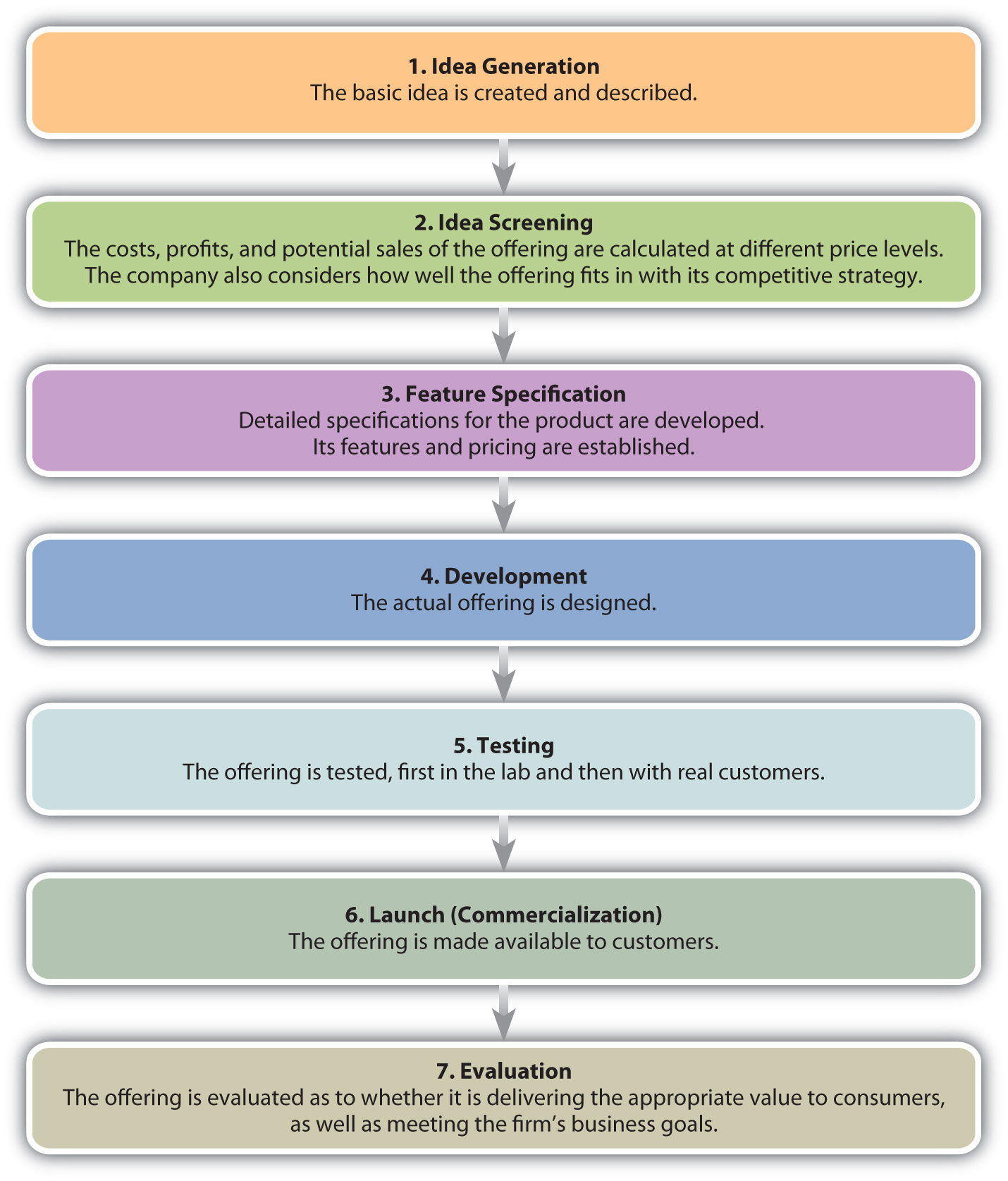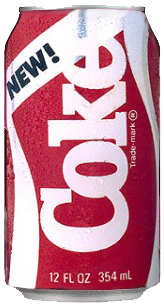Chapter 7: Product
7.4 The New Product Development Process
Learning Objectives
- Identify an effective process for creating products and bringing them to market.
- Understand the relative importance of each step in the new product development process and the functions within each step.
- Distinguish between the various forms of testing and analysis that take place before a new offering is brought to the market.
Most new products go through similar stages in their development process. Although the size of a company will affect how the different stages of their new product development process are conducted and whether products are test marketed before being introduced, the steps are generally the same. figure 7.11 summarizes these steps.

Idea Generation
Many companies, HP and Apple included, were launched in someone’s garage after the founders got an idea for a product and then tried to make and sell it. Apple’s Macintosh microcomputer was a low-cost knockoff of the Xerox Star, a software-equipped workstation. Apple’s cofounder, Steve Jobs, saw the product demonstrated at a Xerox research centre and Xerox was an early investor in Apple (Fisher, 1989).[1]

Researchers, entrepreneurs and even employees often come up with new product ideas, too. 3M’s Post-it Notes are an example. The adhesive that made it possible for Post-it Notes to stick and restick was created by a 3M scientist who was actually in the process of trying to make something else. Post-it Notes came later.

Customers are particularly important co-creators of products when they are consuming products with service components. For example, if you provide your hairdresser with feedback while your hair is being cut, your input will alter the final style you receive. Similarly, a businessperson who provides her certified public accountant (CPA) with information and feedback about her firm will help the CPA develop better financial and tax plans for her business.
Suppliers provide another source of ideas for new products. A supplier might develop a new product or technology that can be used to make yet another product and then go to the makers of those products and suggest new versions of them.
Of course, companies also watch their competitors to see what they’re doing. Some products are protected by patents or copyrights and can’t be legally duplicated. The software that runs Apple’s iPhone is an example. There are, however, different ways to achieve the same results as Apple has with its iPhone. The Samsung Galaxy, manufactured by Samsung, and the Google Pixel, are devices similar to the iPhone that operate with software serving the same purpose.
Innovations like the iPhone are rare. However, many new ideas (and consequently new products) aren’t actually new but rather are versions of products and services already available. A line extension occurs when a company comes out with another model (related product) based on the same platform and brand as one of its other products. When Apple added the Nano and the Shuffle to its iPod line, these were line extensions.
Keep in mind that idea generation is typically the least expensive step in the process of developing a new product, whether you involve customers or not. As you move through the product development process, each step is usually more expensive than the last. Ideas for new products are relatively cheap and easy to generate; what is difficult and expensive is making them a reality.
Idea Screening
Not all new product ideas are good ones. Famous product blunders include Clear Pepsi and Coca-Cola’s New Coke. Less famous is Dell’s cell phone for aging baby boomers. The phone’s large size, large buttons, and large screen screamed “I’m old and blind!” and led potential users to shun it in droves. Yes, even the big companies make mistakes.

The purpose of idea screening is to try to avoid mistakes early in the development process. The sooner bad ideas are discarded, the less the investment made and lost. In the idea screening stage, the company tries to evaluate the new product by answering these questions:
- Does the proposed product add value for the customer? Does it satisfy a market need?
- Can the product be made within a stated time period to get it to market when needed?
- How many units of it will sell and at what price?
- Can we manufacture and sell the product within budget and still make money?
- Do we need to provide the customer with after-sales service? If so, do we have the resources to do that?
- Does the product fit our image and corporate strategy?
Development
In the development stage, the actual product is designed, specifications for it are written, and prototypes of it are developed. It is also during this stage that the firm considers the product’s manufacturing process. For example, when a restaurant is developing a new dish, it must not only taste good, as it must also be a dish that can be made in a reasonable amount of time once it’s ordered and prepared at a cost that earns the restaurant a profit. In terms of a manufacturer’s products, using the same technology platform as another product (like Apple has done with iPhones) can be more effective and cheaper. Using the same platform also generally makes it easier for a company to train its technicians to service a new product.
Testing
During the testing stage, the product is tested, first in the lab and then with real customers. Lab testing is also called alpha testing. Alpha testing ensures that the product works like it’s supposed to in a variety of different environments. For example, Kraft might launch a new food product that has to work in hot climates, cold climates, high humidity, dry climates, and high altitudes—all conditions that can change how well the product works.
The next step is beta testing. During beta testing, actual customers make sure the product works under real-world conditions. Beta testing not only tests whether the product works as advertised but also tests the product’s delivery mechanisms, service processes, and other aspects of marketing the product. This step can be expensive. Depending on the product, some companies might find it better to simply launch the product and let the market respond to it or test it once it is available for purchase.
Launch or Commercialization
Once a product has been designed and tested, it is made available to customers. Sometimes a company launches the product to all its markets at once. Other companies may use a rolling launch in which the product is made available to certain markets first and then other markets later. A rolling launch might make sense if the company’s service technicians need training. The company makes the product available to one market after the first batch of its employees are prepared to service the product; then, as new batches of employees are prepared to service the product, the company enters more markets.
Some companies test the complete launch of a product’s marketing plan to ensure that it reaches buyers, gets positive feedback, and generates sales of the product or service. This is called a market test. Companies may conduct market tests in limited markets or nationwide. For example, when one beverage maker tested the marketing plan for a new wine cooler, the firm first launched the product on the east coast, where the beverage was promoted as a “Polynesian” drink; on the west coast, the beverage was promoted as an “Australian” drink. The Polynesian version proved more popular, so in other new markets, that’s how the beverage was advertised and packaged.
Evaluation
Once a product is launched, a firm’s executives carefully monitor its progress. You have probably heard about the “box office” sales for new movies the first weekend following their release. The first weekend is a good predictor of how much money a movie will make overall. If the ticket sales for it are high during the first weekend, a studio’s executives might decide to beef up the promotions for it. If the ticket sales for the movie are low, the studio might stop screening the movie in theatres altogether and release it on a streaming service instead. For other types of products, important milestones might be the first ninety days after the product is launched, followed by a second period of ninety days, and so forth. However, be aware that firms are constantly in the process of evaluating their products and modifying them by either adding or subtracting the features and services associated with them, changing their prices, or how they are marketed. The length of time for milestones used to evaluate products may vary depending on the organization and other products or services being developed.
Key Takeaways
Most companies put new product ideas through a seven-step process, beginning with the idea generation stage. Ideas for new offerings can come from anywhere, including one’s customers, employees, suppliers, and competitors. The next step in the process is the idea screening stage, followed by the feature specifications, development, testing, and launching stages. After a product is launched, it is evaluated. A company must balance a product’s investment risk (the risk associated with losing the time and money put into developing the product) against the product’s opportunity risk (the risk associated with missing the opportunity to market the product and profit from it).
Review and Reflect
- What are the seven steps in the product development process? What are the key activities in each step?
- How should a company evaluate new ideas? What are the criteria?
- Understanding the process of creating offerings is useful and valuable for a lot of different business settings. Let’s see if you can remember the order of steps and the details of each step.
Media Attributions
- The New Offering Development © University of Minnesota Libraries is licensed under a CC BY-NC-SA (Attribution NonCommercial ShareAlike) license
- Fila inline skates © Santeri Viinamäki is licensed under a CC BY-SA (Attribution ShareAlike) license
- post-it notes © Dean Hochman is licensed under a CC BY (Attribution) license
- New Coke can © Jetijonez is licensed under a CC BY (Attribution) license
- Fisher, L. M. (1989, December 15). Xerox sues Apple computer over Macintosh copyright. New York Times. Accessed January 20, 2010. ↵
when new but similar products are added to the product line
to ensure that the product works like it’s supposed to in a variety of different environments
having actual customers make sure the product works under real-world conditions
the product is made available to certain markets first and then other markets later
test the complete launch of a product’s marketing plan to ensure that it reaches buyers, gets positive feedback, and generates sales of the product or service

